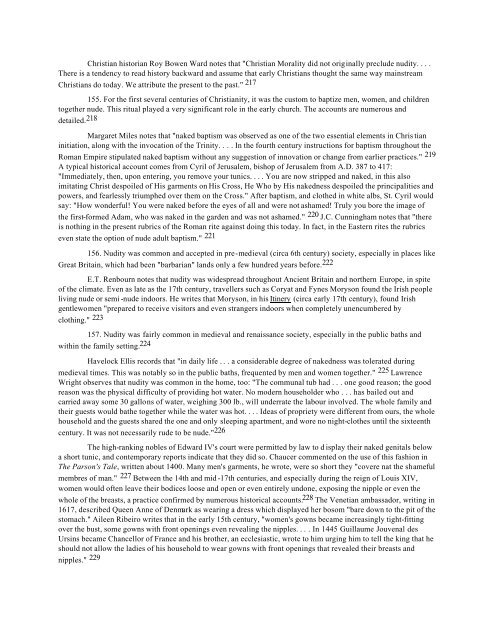Create successful ePaper yourself
Turn your PDF publications into a flip-book with our unique Google optimized e-Paper software.
Christian historian Roy Bowen Ward notes that "Christian Morality did not originally preclude nudity. . . .<br />
There is a tendency to read history backward and assume that early Christians thought the same way mainstream<br />
Christians do today. We attribute the present to the past." 217<br />
155. For the first several centuries of Christianity, it was the custom to baptize men, women, and children<br />
together nude. This ritual played a very significant role in the early church. The accounts are numerous and<br />
detailed. 218<br />
Margaret Miles notes that "naked baptism was observed as one of the two essential elements in Chris tian<br />
initiation, along with the invocation of the Trinity. . . . In the fourth century instructions for baptism throughout the<br />
Roman Empire stipulated naked baptism without any suggestion of innovation or change from earlier practices." 219<br />
A typical historical account comes from Cyril of Jerusalem, bishop of Jerusalem from A.D. 387 to 417:<br />
"Immediately, then, upon entering, you remove your tunics. . . . You are now stripped and naked, in this also<br />
imitating Christ despoiled of His garments on His Cross, He Who by His nakedness despoiled the principalities and<br />
powers, and fearlessly triumphed over them on the Cross." After baptism, and clothed in white albs, St. Cyril would<br />
say: "How wonderful! You were naked before the eyes of all and were not ashamed! Truly you bore the image of<br />
the first-formed Adam, who was naked in the garden and was not ashamed." 220 J.C. Cunningham notes that "there<br />
is nothing in the present rubrics of the Roman rite against doing this today. In fact, in the Eastern rites the rubrics<br />
even state the option of nude adult baptism." 221<br />
156. Nudity was common and accepted in pre-medieval (circa 6th century) society, especially in places like<br />
Great Britain, which had been "barbarian" lands only a few hundred years before. 222<br />
E.T. Renbourn notes that nudity was widespread throughout Ancient Britain and northern Europe, in spite<br />
of the climate. Even as late as the 17th century, travellers such as Coryat and Fynes Moryson found the Irish people<br />
living nude or semi -nude indoors. He writes that Moryson, in his Itinery (circa early 17th century), found Irish<br />
gentlewomen "prepared to receive visitors and even strangers indoors when completely unencumbered by<br />
clothing." 223<br />
157. Nudity was fairly common in medieval and renaissance society, especially in the public baths and<br />
within the family setting. 224<br />
Havelock Ellis records that "in daily life . . . a considerable degree of nakedness was tolerated during<br />
medieval times. This was notably so in the public baths, frequented by men and women together." 225 Lawrence<br />
Wright observes that nudity was common in the home, too: "The communal tub had . . . one good reason; the good<br />
reason was the physical difficulty of providing hot water. No modern householder who . . . has bailed out and<br />
carried away some 30 gallons of water, weighing 300 lb., will underrate the labour involved. The whole family and<br />
their guests would bathe together while the water was hot. . . . Ideas of propriety were different from ours, the whole<br />
household and the guests shared the one and only sleeping apartment, and wore no night-clothes until the sixteenth<br />
century. It was not necessarily rude to be nude." 226<br />
The high-ranking nobles of Edward IV's court were permitted by law to d isplay their naked genitals below<br />
a short tunic, and contemporary reports indicate that they did so. Chaucer commented on the use of this fashion in<br />
The Parson's Tale, written about 1400. Many men's garments, he wrote, were so short they "covere nat the shameful<br />
membres of man." 227 Between the 14th and mid -17th centuries, and especially during the reign of Louis XIV,<br />
women would often leave their bodices loose and open or even entirely undone, exposing the nipple or even the<br />
whole of the breasts, a practice confirmed by numerous historical accounts. 228 The Venetian ambassador, writing in<br />
1617, described Queen Anne of Denmark as wearing a dress which displayed her bosom "bare down to the pit of the<br />
stomach." Aileen Ribeiro writes that in the early 15th century, "women's gowns became increasingly tight-fitting<br />
over the bust, some gowns with front openings even revealing the nipples. . . . In 1445 Guillaume Jouvenal des<br />
Ursins became Chancellor of France and his brother, an ecclesiastic, wrote to him urging him to tell the king that he<br />
should not allow the ladies of his household to wear gowns with front openings that revealed their breasts and<br />
nipples." 229


